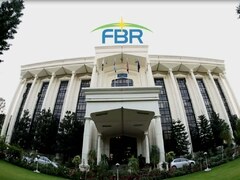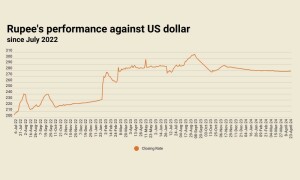LONDON: Britain's pound hits its lowest level in three weeks against the dollar on Tuesday, suffering its worst day in a month as weakening risk sentiment weighed on global stock markets, hitting risk-correlated currencies including the commodity-linked Australian, Canadian and Kiwi dollars.
Global stock markets were in the red for a second day running as an unexpectedly weak set of Chinese economic data along with unrest in Afghanistan and other factors weighed on appetite for riskier assets.
The pound hit its weakest level since July 26 at 1442 GMT, falling as much as 0.7% on the day to $1.3744. The 0.7% drop was its biggest daily loss since June 18. Against the euro it hit a two-week low of 85.35 pence.
The market mostly overlooked positive jobs data. As Britain's economy extended its recovery, payrolls rose by 182,000 in July to 28.9 million, data showed - 201,000 shy of the level seen before the COVID-19 pandemic hit in March 2020.
The Office for National Statistics also said the headline unemployment rate fell to 4.7% in the three months to June, its lowest since the three months to August 2020.
Economists polled by Reuters had mostly expected the unemployment rate to hold at 4.8%.
"The pound continues to struggle despite the overall better than expected labour market data out of the UK: the unemployment rate came in a tad lower and the weekly earnings were stronger than expected, while the employment gains continued at a healthy clip in June," said Valentin Marinov, head of G10 FX research at Credit Agricole.
"The slightly less good news was the fact that the claimant count continued to grow in July with the drop in total jobless claims that we saw in June stagnating in July. The data has offered the pound relatively little support likely because the labour market conditions in the UK are expected to soon start deteriorating again after the expiry of the government's furlough scheme next month."
On Wednesday, investors will look to UK inflation figures, with the market consensus expecting inflation to ease.
That will reduce pressure on the Bank of England to normalize monetary policy any time soon, Marinov said.
"All this, coupled with the heightened pound sensitivity to risk sentiment, makes us keep our cautious outlook on the pound in the near term. Indeed, FX investors could continue to look for hedges against further escalation in risk aversion and may found the pound an attractive short, given current valuation and market positioning."
Sterling has traded in line with risk sentiment in recent weeks, and has been among the top-performing currencies in the 'G10' group.
Speculators' positioning on the pound turned net long in the week to Aug. 10, according to weekly CFTC positioning data. This means that the speculative market generally expects the pound to strengthen.
"Sterling has slipped into subdued trading after failing to hold onto gains last week," ING said in a note to clients.
"Today's June employment data understandably has delivered little fresh news with the market instead waiting for this autumn to see the end of furlough schemes and how much unemployment rises then."
ING said 84.50-85.50 pence per euro may now be the broad boundaries of a euro-sterling range, with low volatility potentially extending into September.























Comments
Comments are closed.